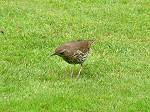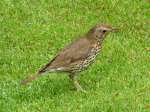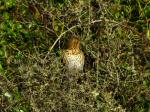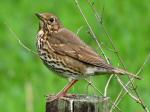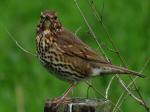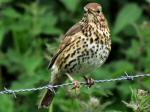Latin name - Turdus philomelos
A once familiar sight, Song thrush numbers have declined rapidly in the
United Kingdom and it is on the RSPB's red list. It can be seen anywhere
where there are trees and bushes including gardens and parks as well as
its more traditional haunts of woodland, both deciduous and coniferous,
and farm hedgerows. Both sexes are the same with brown upper-parts, pale
under-parts covered in dark speckles. They have pink legs and orange colouration
underneath the wing which can be seen when they are in flight. The young
have buff coloured streaks on their backs. They eat worms, insects, berries,
and snails and will take kitchen scraps if left out for them. They crack
open snails by hitting them repeatedly against a stone or other hard object,
a feeding behaviour which has become famous. |
